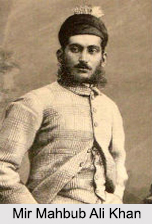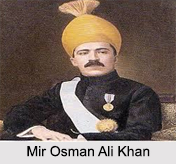 During British rule in India (which covers both the British East India Company rule from 1757 to1858 and later the British Raj from 1858 to 1947), the princely state of Hyderabad was ruled by many princes. They had served the state under the title of "Nizam" and belonged to the Asaf Jah Dynasty. Given below are the Nizams of Hyderabad.
During British rule in India (which covers both the British East India Company rule from 1757 to1858 and later the British Raj from 1858 to 1947), the princely state of Hyderabad was ruled by many princes. They had served the state under the title of "Nizam" and belonged to the Asaf Jah Dynasty. Given below are the Nizams of Hyderabad.
Mir Nizam Ali Khan, Asaf Jah II
Nizam Ali Khan, the Nizam of Hyderabad State ruled the period between 1762 and 1803. In the year 1759, Nizam Ali was appointed as the leading commander and administrator of the Deccan. On 8th of July, 1762, Asaf Jah II became the Subedar of the Deccan. In 1763, he transferred his capital from Aurangabad to Hyderabad as Aurangabad was very close to the area controlled by the Marathas. Being fearful of the rise of highly capable people like Hyder Ali, Nizam Ali Khan made intense attempts to disturb the relations between the Mughal Emperor and the Sultanate of Mysore.
Mir Akbar Ali Khan Sikander Jah, Asaf Jah III
 Akbar Ali Khan, the Nizam of Hyderabad ruled from 1803 to 1829. At the time, a British cantonment was established in Hyderabad and the area was christened after him as Secunderabad. During his tenure, the state faced financial disturbances.
Akbar Ali Khan, the Nizam of Hyderabad ruled from 1803 to 1829. At the time, a British cantonment was established in Hyderabad and the area was christened after him as Secunderabad. During his tenure, the state faced financial disturbances.
Mir Nasir-Ud-Dawlah, Asaf Jah IV
Nasir-Ud-Dawlah, the Nizam of Hyderabad ruled from 1829 to 1857.
Mir Afzal Ad-Dawlah, Asaf Jah V
Afzal Ad-Dawlah, the Nizam of Hyderabad ruled from1857 to 1869. The area under his rule was divided into five subahs and sixteen districts. During his reign, Afzal Ad-Dawlah reformed the Hyderabad revenue and judicial systems, instituted a postal service and constructed the first rail and telegraph networks. In 1861, he was awarded the Star of India.
Mir Mahbub Ali Khan, Asaf Jah VI
Mahbub Ali Khan, the Nizam of Hyderabad ruled the period between 1869 and 1911. Mahbub Ali Khan was a respected ruler. His popular name was Mahbub Ali Pasha. Clothes attracted him so much that he maintained a collection of garments which was one of the most extensive in the world at the time. A whole wing of his palace was dedicated to his wardrobe and would never wear the same dress twice. He was also fascinated towards cars. He bought the Jacob Diamond, which stands out among the Jewels of The Nizams, now owned by the Government of India.
Mir Osman Ali Khan, Asaf Jah VII
Osman Ali Khan, the last Nizam of Hyderabad ruled the period between 1911 and 1948. He was a benevolent ruler which can be comprehended from the fact that he patronized education, science and development. Electricity was introduced during his tenure and there was development of railways, roads and airways. The excavation of the Nizamsagar Lake in Hyderabad state was undertaken along with some irrigation projects on the Tungabhadra River.



















